Bolts are a component which are typically used with nuts to fasten two parts together. They are an alternative option to rivets and welding, which are much harder to undo.
Most bolts are hex head bolts, which means they have six sides for a wrench to grab on to. There are also four-sided bolts, but these are rare.
Square nuts are more commonly used where they are able to be held by the components being held together, such as on battery connectors.
Lock Nuts
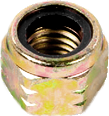
Sometimes a nut needs to lock on to the bolt so that it wouldn't be shaken loose or otherwise loosened. There are a few different designs, including the nylon insert type, as seen at the right. Another lock nut design slightly changes the thread angle, so that when it is tightened, the threads of the nut strain against the thread of the bolt.
Lug Nuts
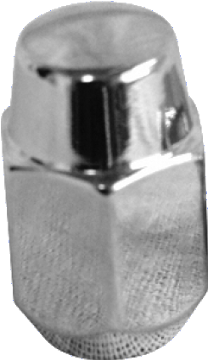
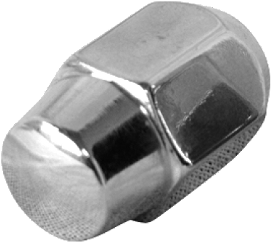
Most lug nuts have nothing special in their design, but are heavy duty and vary based on how they mount to the rim. Many take on the common hexagonal design of other nuts, while others have special designs for added security. Many are zinc coated or chrome plated for corrosion resistance.
Reverse Thread Lug Nuts
Reverse thread or "left handed" lug nuts were found on vehicles more commonly when one center lug nut was the normal type used, and did exist on multi-lug style hubs for a while as that style became more common.
Wing Nuts
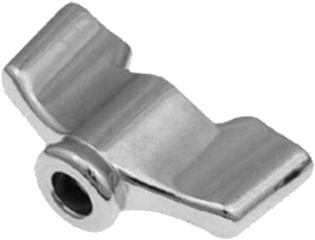
Wing nuts are quite different in design than most others, since they are meant to be tightened or loosened by hand, rather than with tools. Two "wings" extend out from the round threaded portion of the nut. Wing nuts typically aren't used in high torque applications.
Flange Nuts
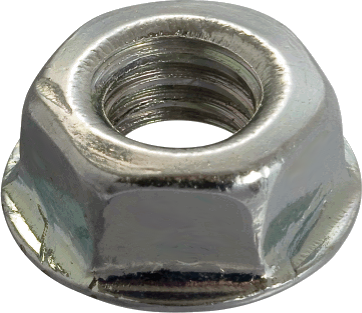

A flange nut looks like a basic nut with a washer built into one side of it. The "washer" section is part of the nut and doesn't move independently. Sometimes the "washer" base of the nut has a high friction or serrated design, like a lock washer, such as the golden (zinc-coated) locking flange nut seen at the right. Flange nuts (without lock designs) are sometimes used to keep the surface they press against form being damaged.
Cap/Acorn Nuts
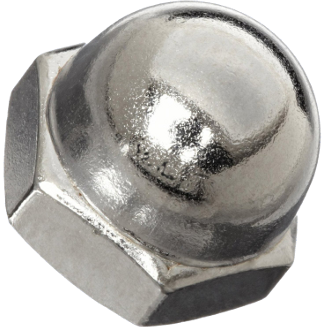
A cap nut, or acorn nut, is a nut which has a top to it, often domed, which doesn't allow a bolt or other component to pass completely through it. These are often used to create a more aesthetically-pleasing look. Cap nuts can also be used to cover a sharp surface, which is useful in locations where people may bump into it.
Coupling Nuts
When two threaded bolts or other components need to be connected together, a coupling nut is used. Reducing coupling nuts are used when the two bolts have different thread sizes.
Square Nuts

Fairly uncommon in automotive use, square nuts are a four-sided nut (as opposed to the typical hexagonal/six-sided nut) design which provides much more surface area to the wrench.
Tee/T Nuts
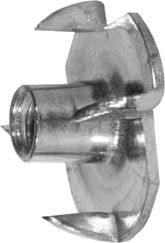

Not commonly found in automotive use, tee nuts, or T-nuts, are designed to grab into semi-soft materials (like wood, rubber, or plastic) and create an internal thread point for bolts and the like to connect to.
Banjo Bolts
A banjo bolt is a specialized type of bolt that is paired with a banjo fitting and various types of sealing materials. The bolt itself is
Nut/Bolt Head Sizes
Both nuts and bolts both come in Metric and Standard. Metric is measured in millimeters, and standard is measured in fractions of an inch.
Common Automotive Metric Head Sizes
- 4mm
- 4.5mm
- 5mm
- 6mm
- 7mm
- 8mm
- 9mm
- 10mm
- 11mm
- 12mm
- 13mm
- 14mm
- 15mm
- 16mm
- 18mm
- 20mm
- 22mm
- 24mm
- 30mm
- 33mm
- 34mm
- 35mm
Common Automotive Imperial Head Sizes
- 1/8 in.
- 3/16 in.
- 1/4 in.
- 5/16 in.
- 3/8 in.
- 7/16 in.
- 1/2 in.
- 9/16 in.
- 5/8 in.
- 3/4 in.
- 13/16 in.
- 7/8 in.
- 1 in.
- 1 1/16 in.
- 1 1/2 in.
How Bolts and Nuts are Made by How It's Made
This video shows one of the ways bolts are made, followed by the standard way nuts are made.
